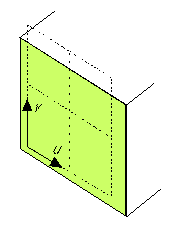TAPESTRY: The Art of Representation and Abstraction
Texture Maps: Transparency Maps
What's it all about?
To solve the basic Cosine shading equation

we need to figure out what the underlying color (ks) is of the portion of the surface being viewed. Image maps (aka diffuse color maps, color maps, etc.) answer this question in terms of where that portion of the surface is on the larger object

.gif)
The basic "setup" for the image map is the same as most mappings: A (u,v)-coordinate system is attached to the underlying geometry. This two-dimensional coordinate system is "on" the surface, and thus allows us to associate a picture with the geometry itself.
Selecting your "wrapping paper"
There are three common strategies for selecting the color, sometimes (confusingly) referred to as mapping types. As used here, mapping type refers to the fashion in which the color is identified. It can also be used to refer to the way in which it is applied. First, let us look at how the color is computed. There are three broad strategies for this: constant color, lookup tables (aka image maps), and calculated (procedural) maps.
- Constant Value
- Image Lookup
- Procedural Calculation
Last updated: April, 2014
